SHIP-TO-SHIP AND SQUADRON-TO-SQUADRON ENGAGEMENTS
OVERVIEW
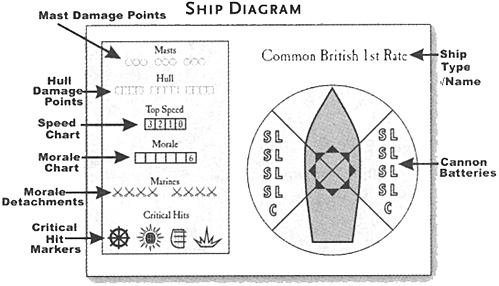 Hold Fast is meant as an introductory / table top miniatures game of ship to ship and squadron to squadron naval engagements during the latter half of the 18th and early part of the 19th centuries. The rules are meant to convey a sense of the issues facing commanders during that period while allowing players to get into play quickly.
Hold Fast is meant as an introductory / table top miniatures game of ship to ship and squadron to squadron naval engagements during the latter half of the 18th and early part of the 19th centuries. The rules are meant to convey a sense of the issues facing commanders during that period while allowing players to get into play quickly.
Hold Fast is not meant to be an exhaustive simulation of Naval Warfare in the Age of Sail, as many such fine simulations exist already. If you already know how to maneuver your enemy three points to the leeward bow to gain the weather gauge, this game may not be for you. Rather, Hold Fast is meant to be an accessible Age of Sail game you can run quickly and easily with a small number of ships on the average tabletop in 90 minutes or less.
MINIATURE SCALE
1:1800 to 1:2400. These rules are designed for 1:1800 to 1:2400 scale sailing ships. If you wish to use another scale, please adjust ranges and movement rates accordingly.
PLAYING SURFACE
1 inch = 300 yards
Due to the scale of the game, ranges and movement are not wide ranging for the average encounter. You can play the game on just about any table top surface, including your average card table. Measurements are given in Imperial measurements, with ranges and speeds calculated in inches. Port and Starboard maneuvers are rated in up to 45 degree increments.
You may also play the game on a point to point grid map. When using the grid map, movement increments are rated on a 1.5 inch grid and all turns are calculated in 45 degree turns.
GAME TURNS
Game turns are played in a series of 5 phases each.
Each phase represents approximately 2 minutes.
Each turn (or five phases) thus represents approximately 10 minutes.
MOVEMENT ACTIONS:
During a phase, ships may do perform one of the following Movement Actions depending on their speed:
- Turn 45 degrees to port
Turn 45 degrees to starboard
Move 1 inch forward
Raise Sail/ Lower Sail (once per turn)
Drop Anchor/ Raise Anchor (once per turn)
During a phase, regardless of other actions, a ship may always fire.
SHIP DIAGRAM
PLAY SEQUENCE
1. Movement Orders
2. Phase I Movement and Combat
3. Phase II Movement and Combat
4. Phase III Movement and Combat
5. Phase IV Movement and Combat
6. Phase V Movement and Combat
7. Damage Control
SEQUENCE I - MOVEMENT ORDERS
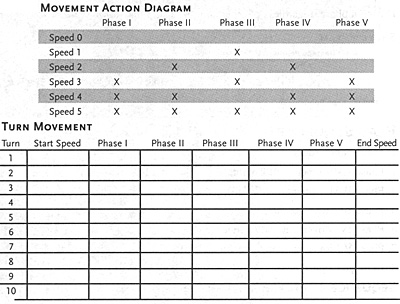 During this sequence, each player plans the movement for their ships for the coming turn. Players must plan movement for all five phases of the coming turn. Once the orders are given, they may not be changed until the next movement orders sequence.
During this sequence, each player plans the movement for their ships for the coming turn. Players must plan movement for all five phases of the coming turn. Once the orders are given, they may not be changed until the next movement orders sequence.
Players denote orders using simple notation each turn:
- Up Arrow = Move Forward
Left Arrow = Turn to Port
Right Arrow = Turn to Starboard
DA = Drop Anchor
W A = Weigh Anchor
RS = Raise Sail (Once Per Turn)
LS = Lower Sail (Once Per Turn)
D = Drift
RECORDING MOVEMENT ACTIONS
Players should record their movement actions during the Movement Orders sequence of each game turn. Players then reveal their movement actions to the other players on a phase by phase basis.
The following chart is provided for ease of organization to denote movement per turn:
SEQUENCES 2-7: MOVEMENT AND COMBAT MOVEMENT AND SPEED
Ships may perform a movement action once per phase based on their present speed, the speed meaning how many phases per turn in which a ship may perform a movement action. The fastest possible speed in the game is 5, meaning that a ship traveling at speed 5 may perform a movement action once per phase. Ships may travel at speeds between 0 and 5. Each ship's top speed is listed in its description.
Movement is considered simultaneous during each phase, with players revealing the orders they recorded during the Movement Orders sequence. The order in which players conduct their moves is not critical, so players should agree upon the order amongst themselves.
SEA LIFE GROWTH AND ITS AFFECT ON SPEED
The accumulation of growing organisms along the bottom of a ship (barnacles or sea plants growing along the ship's hull) was a constant problem for ships at sea, and warships were no exception. When a ship's speed was reduced by such growths so badly, the ship had to be brought on shore and the growths removed. This process, called careening, was time consuming, and left the ship vulnerable if the careening had to be done far from home port. A ship's speed rating for a particular scenario may be reduced from the standard of her type because of such growths.
COPPER CLADDING
At the end of the 18th Century, it was discovered that thin copper plates attached to the bottom of a ship retarded the growth of barnacles and plant life; so many ships were taken to port to have these copper plates added. This allowed a ship to remain at sea for longer periods before the need for careening.
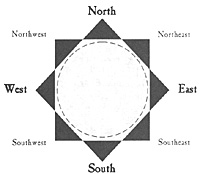 MOVEMENT DIRECTION
MOVEMENT DIRECTION
Movement in Hold Fast is calculated on the eight ordinal points of the compass as follows:
Whenever a ship moves, it should move in one of the ordinal directions.
MOVEMENT EXAMPLES:
The HMS Belephron is moving at a speed of 2, thus it is able to perform movement actions during Phase II and Phase IV only. However, it may fire during each of the five phases. The captain of the Belephron wishes to turn to Port to the Southwest and then to move forward. His movement chart for this turn will look like this:
 Players looking to record their battles to a greater degree of accuracy should include the direction the ship is facing at the end of the movement action in their movement chart. Thus, the previous chart would look like this if the players are recording detailed movement info:
Players looking to record their battles to a greater degree of accuracy should include the direction the ship is facing at the end of the movement action in their movement chart. Thus, the previous chart would look like this if the players are recording detailed movement info:
The French Vengeur is moving at a speed of 3, thus it is able to per form a movement action in Phase I, Phase III and Phase V Like the Belephron, it may fire during each of the five phases. The Captain of the Vengeur decides to move forward twice to the East, and then turn to Starboard to the Southeast. His simple movement chart for this turn will look like this:
MOVE FORWARD
Move the ship 1 inch forward from its current position. Movement is always determined from the bow (or front most part) of the ship.
TURN To PORT/ TURN To STARBOARD
For you land lubbers, Port is left, while Starboard is right. A turn to Starboard allows a player to make a turn to the right 45 degrees, while a turn to Port allows a player to make a turn to the left 45 degrees.
To aid players in executing turns, the following guide is provided. Make as many photocopies as you need and cut out the center to aid in your movement calculations:
LOOSE MOVEMENT
Hold Fast is a gentlemanly game, and thus players may `fudge' their movements up to 5 degrees in any direction to perform more precise maneuvers. Though such `fudging' may not be used to avoid collisions with other ships or hazards.
RAISE SAIL/ LOWER SAIL
In addition to normal movement actions, once per turn players may choose to raise or lower sail. This increases or decreases the speed of the ship by one. Ships may not raise sail to increase their speed over the maximum. When a ship raises or lowers sail, the action must be declared to the group, as all ships can see when a ship performs this action.
A ship may raise or lower sail during ANY phase regardless of their speed, though the action MUST be planned for in advance during the Movement Orders sequence. Once this action is performed, the ship finishes the turn as if they are traveling at the new speed.
EXAMPLE:
The Captain of the HMS Victory is traveling at speed 2 at the beginning of his turn. He realizes that his prey will escape him if he doesn't speed up, so he plans to raise sail immediately during Phase I. Since his speed is only 2, the only action he may plot for Phase I is to raise sail. However, the rest of the turn is thus calculated as if the Victory were traveling at speed 3. Thus the Victory may perform movement actions during Phases III and V.
(It should be clear that controlling when you decide to raise or lower sail has a major impact on movement, and thus players should plan carefully how their decision to raise or lower sail affects their position during a turn.)
FULL SAIL (OPTIONAL RULE)
If a ship is traveling at full speed, all of its sails are unfurled, making them vulnerable to attack. If a ship is at full sail and receives damage to the ship's masts, mark off two mast circles from the mast damage chart instead of one for each mast hit received (see Combat Damage below).
DROP ANCHOR/ WEIGH ANCHOR
When a ship reduces its speed to zero, it may drop anchor in order to remain stationary. A ship that has dropped its anchor is called `at anchor' and does not move. It may not turn, move forward, drift or raise or lower sail. If a ship is at anchor, it may still fire its guns.
In order to move again once a ship has dropped anchor, it must weigh anchor (or pull the anchor up). This action requires a movement action, and thus takes up a movement phase. Once a ship has weighed anchor, it may raise sail and begin to move again.
DRIFTING
A ship that has reduced speed to zero but does not weight anchor will begin to drift. If a ship remains at speed zero at the end of Phase V, it drifts one inch downwindin the opposite direction the wind is coming from (see below). This is true even if the ship lowers sail to speed zero during Phase V. A ship must drop its anchor to stop its drift.
WIND DIRECTION
The direction of the wind affects the ability of sailing ships to maneuver. The real affects of wind on the speed and maneuverability of a sailing ship can be quite complex. For purposes of this game, wind direction has been simplified to ease play, while still having a profound affect on the movement of vessels. Direction of the wind is always discussed in terms of the direction the wind is coming from. At the beginning of a scenario, the basic wind direction is determined along the eight ordinal compass points as per the standard movement rules.
Each scenario lists the beginning wind direction.
In Hold Fast, no ship may move forward in the direction the wind is coming from. Ships may still make movements to port or starboard, raise or lower sail, or raise or drop anchor, but they may not move against the direction of the wind. If a player attempts a forward movement into the wind, it will have the same affect as a anchor drop anchor movement (no movement at all).
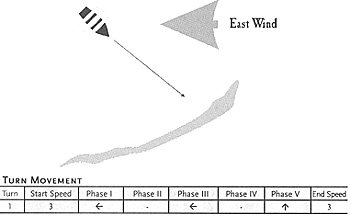 EXAMPLE:
EXAMPLE:
The HMS Belephron is being chased by another vessel and has been fleeing to the Southeast. However, ahead and to the South of the Belephron is a line of shoals that block movement. The wind, however, is coming from the East.
Not wishing to run his ship aground, the Captain of the Belephron has no choice but to turn his ship into the wind and then attempt to escape to the Northeast. He is traveling at speed 3, so during Phase I he turns Port to the East. He may not move forward while facing East, so during Phase III he turns Northeast. Now the Belephron may move forwvard again, so during Phase V, the Captain of the Belephron moves his ship Northeast.
WIND SHIFT (OPTIONAL RULE)
During the Movement Orders sequence at the start of each turn, have one player roll a d6. If a 6 is rolled, the wind direction shifts from its current direction. Roll another d6 to determine the new direction of the wind:
- Result:
1-3 Shift the wind one compass point clockwise
4-6 Shift the wind one compass point counter-clockwise Roll another wind check at the beginning of the next turn.
EXAMPLE
During a scenario, the wind is coming from the North. On turns 1, 2 and 3 the wind shift roll results in something other than 6, so no wind shift occurs. On turn 4, the player rolling for wind shift rolls a 6. He then rolls a 2, meaning that the wind shifts one compass point clockwise, shifting the wind from North to Northeast. Until another wind shift roll is made, the winds will blow from the Northeast.
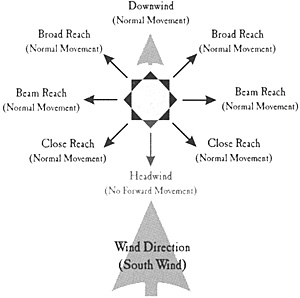 DIRECTIONAL JARGON
DIRECTIONAL JARGON
In sailing terms, ships either travel Downwind (with the wind), on a Close Reach with the wind (45 degrees off the direction the wind is coming from), on a Broad Reach with the wind (135 degrees off the direction the wind is coming from), or on a Beam Reach (90 degrees off the direction the wind is coming from). The following diagram gives an example of ship movement for a Southerly Wind:
You don't need to use these terms during game play, but it does add a bit of spice to the table when you announce that your ship is `Running a close reach with the wind to starboard.'
SHIP RATINGS
Ships throughout the age of sail were defined by the number of guns the ship was outfitted with. Ships of the line, in general, had to be 3rd rate or better, while 4th rate and lower ships were considered too weak to be considered for line duties, but were perfectly suited for either raiding or protecting commerce vessels, showing the flag in far flung colonies, or for serving as regional seagoing muscle.
The classification of ships into each of the ratings varies with the source used and the time period in question. These definitions also evolved as sea warfare evolved. As the age of sail wore on, the minimum definition of ship ratings grew until by the period of the American and French Revolutions, the minimum number of guns for a ship of the line grew considerably.
For the period covered by the basic rules of Hold Fast, the guidelines for ship classification are as follows:
- 1st Rate- Typically 100 or more guns
2nd Rate- Typically 90 or 94 guns
3rd Rate- Typically 60, 74 or 80 guns
4th Rate- Typically 40, 44 or 50 guns
5th Rate- Typically 32, 36 or 38 guns
6th Rate- Typically 18 or 24 guns
Rated ships below 3rd rate were known as Frigates. There were also some heavily armed unrated ships such as sloops, brigs and corvettes. Some of these vessels rivaled rated ships in terms of speed and firepower. Ships often carried more or less cannons than they were rated for. For instance, the USS Constitution was rated as a 44-gun ship, but carried 54 guns into battle. In the ship diagrams presented in these rules, ships are rated by the number of cannon they were carrying at the time of the action, not what they were originally rated for.
CANNONS
The types of guns mounted on combat vessels are divided into three classes for purposes of this game:
LONG RANGE GUNS
(Denoted by an L on the ship diagram)
Maximum Range- 4"
These are typically 18-24 pound guns designed to hit targets at a long range. These cannons do one point of damage per hit on target. If fired while alongside another ship (range zero), these cannons do two points of damage per hit on target.
SHORT RANGE GUNS
(Denoted by an S on the ship diagram)
Maximum Range- 3"
These are typically 6-12 pound guns designed to hit targets at a shorter range. These cannons do one point of damage per hit on target regardless of range.
CARRONADES
(Denoted by a C on the ship diagram)
Maximum Range- 1"
These are very short range cannons that fire VERY heavy shot. They do two points of damage per hit at the expense of their range. If fired while alongside another ship (range zero), these cannons do three points of damage per hit on target.
BATTERIES
Since rolling over 50 die rolls per turn for a 1st Rater is impractical in game terms, each ship's guns are grouped into batteries. Roughly, a battery consists of about six cannons (with some variance for cannon sizes and odd fittings). Thus a 1st rater may have upwards of 17-20 batteries.
EXTRA GUNS
Some ships were fitted with extra guns that don't fit neatly into the formula used for establishing fittings in Hold Fast. For that reason, some ships will have a + listed next to their fitting (for example C+ indicates additional carronades fitted). When a fitting is listed as a + fitting, add an additional point of damage when any hits are scored by this battery. This represents the extra weight of fire of that battery.
COMBAT PROCEDURE
Combat takes place during each phase AFTER all movement orders have been executed. All combat is considered simultaneous, so all damage is calculated AFTER each player makes his or her attacks.
In order to conduct combat, use the following procedure per battery fired:
- 1. Determine Firing Arc
2. Calculate Target Range
3. Determine Roll Needed To Hit
4. Determine Damage
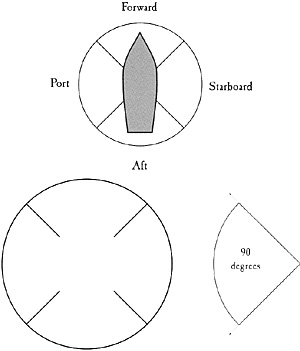 COMBAT STEP I - DETERMINE FIRING ARC
COMBAT STEP I - DETERMINE FIRING ARC
The cannons on sailing vessels were fairly heavy and not terribly mobile. In Hold Fast, cannons are mounted evenly along the starboard and port side of each ship. Ships typically carried only enough crew to fire all the cannons to one side of the ship. Firing arcs are divided into 4 90 degree quadrants aiming forward (in front of the bow), aft (to the stern), port (left) and starboard (right) as follows:
If a target ship straddles two separate firing arcs at once, the firing vessel may choose which arc the ship lies within.
To assist with determining firing arc, you may photocopy and use the following player aids:
BROADSIDES
Warships in the Age of Sail were designed to fire most of their cannon to the sides of the ship. When an enemy vessel is in the Port or Starboard arc of a firing vessel, all of the cannons mounted on that side of the ship may fire at the target. This is known as a full broadside.
BOW AND STERN CHASERS
Sailing Vessels are poorly designed for shots to front (bow) and rear (stern) of the ship. However, Captains did place cannons to the rear and front of the ship during battle when chasing or running from an enemy. If a target is in the Forward or Aft firing arcs, a ship may fire one battery of their choice into that arc. Any battery directed this way is subject to the Multiple Target and Gun Crew Allocation rules below.
MULTIPLE TARGETS
Ships may divide their batteries to fire at multiple targets within an arc. This was done only very rarely, as the standard tactic of the day was to fire all cannons at a single target until it struck its colors. However, there is nothing stopping a Captain from ordering his crew to divide his targets. There is no penalty for doing so (other than having the weight of your fire lessened.)
GUN CREW ALLOCATION
In certain scenarios, ships may be listed as being short some of their crew. Ships often used crews for prize ship duties, or transferred them from ship to ship as needs arose. If a ship is short on crew, the Captain of each vessel decides how to split his fire. Crew allocations should be made before the battle starts. Once in battle, crew may be shifted about, but it takes a full Phase for crew to move to their new location, thus that gun crew may not fire on a phase in which they are reallocating. It is the responsibility of the allocating player to note how his crews are allocated each phase and report this allocation to his adversary.
EXAMPLE:
The HMS Victory, an English 1st Rate has 18 Batteries, 9 on the Starboard and 9 on the Port side. The ship is running short on crew, and has only enough crew to fire 9 batteries at any time. The Victory finds itself between two French 3rd Rates and the Captain, feeling bold, decides to engage them both. Since both vessels are within short range, he decides to fire 4 of his Short Range Cannon to Port, 4 of his Short Range Cannon to Starboard, and his Carronade to Starboard.
During Phase I, one of the French ships moves out of range, and the Captain of the Victory decides to shift his crew to engage the remaining enemy, who now stands on his starboard side. During Phase 11, he shifts all of the gun crews he had previously allocated to port over to the remaining starboard guns. These 4 crew may not fire, however, until Phase III.
COMBAT STEP 2-CALCULATE COMBAT RANGE
Combat ranges are listed inches, and denote the number that needs to be rolled on a d6 to achieve a hit on target. Each type of cannon has a different maximum range as listed above.
CALCULATING RANGE
Range is calculated from the center point of the firing vessel to center point of the target vessel. Measure the distance to determine the range. Each range category indicates the range up to the number listed, thus a range listing of 2" indicates the number needed to hit for a target up to 2" away. A target beyond 2" falls into the 3" range category.
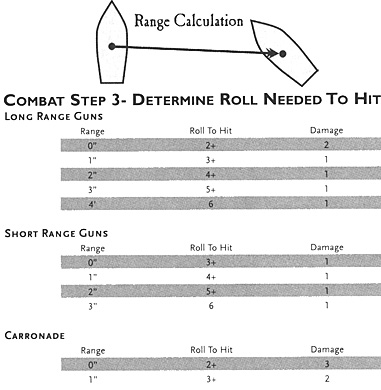 EXAMPLE OF RANGE CALCULATION
EXAMPLE OF RANGE CALCULATION
COMBAT STEP 3- DETERMINE ROLL NEEDED To HIT
To determine the die roll needed to hit, simply compare the type of cannon to the range on the following charts:
Roll one die for each battery fired. If your die roll equals or exceeds the number needed to hit, a hit is scored.
COMBAT STEP 4- DETERMINE DAMAGE
The gun charts above list the amount of damage by the cannon type and the range to target. Damage is determined by rolling on the Damage Chart. One roll on the damage chart is made for each `point' of damage scored.
EXAMPLE:
The USS Constitution scores 2 Long Range Battery hits on an enemy vessel at a range of 2". The Captain of the Constitution thus rolls twice on the Damage Chart. Had the two ships been alongside each other, the Captain of the Constitution would have rolled 4 damage rolls on the Damage Chart.
 DAMAGE CHART
DAMAGE CHART
The damage chart requires the rolling of two six-sided dice. For each hit achieved during combat, roll two dice and compare the row and column result to record the damage listed. To speed play, it is recommended that players roll two different color dice, one representing the Damage Column and the other representing the Damage Row.
DAMAGE RESULTS
When a damage result is scored on the Damage Chart, the following affects are applied:
CANNON
This hit result destroys one of the gun batteries on the targeted vessel. The hit represents the destruction of both the gun AND its gun crew. The battery destroyed should be on the side facing the ship that did the damage. If the shot was taken from directly behind or in front of the target vessel, the targeted ship's Captain determines the side of the ship affected.
If there is more than one type of battery currently available on the targeted vessel, randomly determine which type of battery is affected.
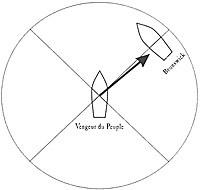 The French ship Vengeur du Peuple is attacking the HMS Brunswick. Since the target ship is straddling both the front and starboard firing arcs, the Captain of the Vengeur du Peuple decides to fire a full broadside from his starboard arc. He scores a Cannon hit on the Brunswick, which must be scored against the guns mounted on the Brunswick's port side, since that is the direction from which the attack was made.
The French ship Vengeur du Peuple is attacking the HMS Brunswick. Since the target ship is straddling both the front and starboard firing arcs, the Captain of the Vengeur du Peuple decides to fire a full broadside from his starboard arc. He scores a Cannon hit on the Brunswick, which must be scored against the guns mounted on the Brunswick's port side, since that is the direction from which the attack was made.
FIRE- (CRITICAL HIT)
Fire is the greatest danger on a wooden ship at sea, and in the midst of combat, fire is an all too common hazard. When a ship receives a fire hit, immediately roll another damage result. Each turn thereafter, roll an additional damage result on the Damage Table regardless of any other combat damage. Fires can put out during the Damage Control Sequence (see below). Hull
HULL
This hit damages the hull of the targeted vessel, affecting her ability to remain afloat. Mark off one hull square on the ship's diagram for each hit received. A ship's hull is divided into three sections. When each section is destroyed, the top speed of the ship is reduced by one. Once the speed of the ship is reduced to zero, it may no longer maneuver, and will drift unless the anchor is dropped (see Drifting above).
If a ship's hull points are reduced to zero, the ship sinks.
Hull points may be repaired during the Damage Control sequence (see below).
MARINES
This hit destroys part of the ship's marine complement. Mark off one marine detachment from the ship's diagram.
MAST
This hit damages the masts or rigging of the targeted vessel. Mark off one mast circle on the ship's diagram for each hit received. Ship's masts are divided into three sections. When each section is destroyed, the top speed of the ship is reduced by one. Once the speed of the ship is reduced to zero, it may no longer maneuver, and will drift unless the anchor is dropped (see Drifting above).
No DAMAGE
The shot hits the enemy vessel, but doesn't do enough damage to affect the ship's performance.
POWDER MAGAZINE (CRITICAL HIT)
Ships of war carry a lot of gunpowder in order to fire the cannons. A hit to the magazine where this powder is stored can be catastrophic. When the Powder Magazine is hit, record an additional three hull hits. In addition to the hull damage, roll an additional hit on the Damage Chart.
RUDDER (CRITICAL HIT)
This hit destroys the ship's rudder. Mark off the rudder symbol on the ship's diagram. While the rudder is destroyed, the ship may not execute a turn maneuver. A ship's rudder may be repaired during the Damage Control Sequence (see below).
WHEEL (CRITICAL HIT)
This hit destroys the ship's wheel, affecting the ship's ability to steer. Mark off the wheel symbol on the ship's diagram. When a ship loses her wheel, she must take a forward movement action BEFORE taking a turn action. Losing your wheel affects any previously planned orders for the existing turn. If a turn action was previously recorded for the turn and the ship does not take a forward movement action BEFORE the turn action, that turn action is converted to a Move Forward Action.
EXAMPLE:
The HMS Bounty is traveling at a speed of 3 when its wheel is destroyed during Phase I. During phases III and V, the Captain had planned a port turn, and then a move forward. Since the ship was not able to execute a forward move BEFORE taking the Turn Action, that turn action is converted to a Move Forward Action, and the ship ends the turn taking two Move Forward Actions. Since the ship ended it's current turn with a Move Forward Action, it may turn to port immediately the next turn. NOTE: Even if the ship's action during Phase I was a move forward action, it still loses it's Turn Action since the combat takes place AFTER movement, and a Move Forward Action must be taken after the wheel's destruction before executing a turn.
A ship's wheel may be repaired during the Damage Control Sequence (see below).
AIMING
Certain Captains developed a tactical preference for where they wished to aim when attacking an enemy ship. Due to the natural rolling of the ship, this aim was not always accurate, but some Captains preferred to aim at the masts of an enemy ship, while others preferred to aim at the waterline.
French Captains, due to the superior speed of their vessels, would typically aim at enemy masts to reduce the speed of their enemies, allowing them to escape. British Captains would typically aim at the waterline of enemy ships, seeking to destroy the enemy cannons or cripple the ship by holing her hull. A sinking vessel was usually quick to surrender. Some scenarios may list aiming conditions for one side or the other. In an open scenario, a Captain may choose whether or not he wishes to aim.
In Hold Fast, damage affects the damage die roll, not the combat die roll. The following rules account for aiming at an enemy's masts or his waterline:
AIMING AT THE MASTS
A Captain who wishes to aim at the enemy's masts should subtract 1 from the Damage Row die roll on the Damage Chart. If the result is a zero, the shot has missed.
AIMING AT THE WATERLINE
A Captain who wishes to aim at the enemy waterline should add one to the Damage Row die roll on the Damage Chart. If the result is a seven, the shot has missed. Ships may not aim while alongside another ship (range zero) since the cannons cannot be trained far enough up or down at that range.
EXAMPLE:
The French ship, Tonnant, is engaged with an enemy vessel. Her Captain decides to aim his cannons for the enemy's masts. He scores two hits with long range cannon at a range of 4 inches. He rolls for damage, rolling a 2,4 and a 1, 5, which, due to his aiming for the masts, convert to a 1,4 and 0,5. The first hit thus scores a hit against the enemy Marines, while the second hit becomes a miss.
OLD IRONSIDES- IRONSIDES
As the age of sail drew on, some French and American ships began to use a new, thicker type of construction method. Such ships were harder to destroy with the smaller, short range cannon many lower rated ships carried. Ships with the designation Ironsides are `denoted' in the ship listings. When these ships are struck by a Short Range battery in combat, any 1 or 2 results on the Damage Column die roll result in `No Damage.'
EXAMPLE
The USS Constitution is rated as an Ironsides vessel. It is hit with twice with short range batteries, and once with a long range battery at a range of 2". The attacker rolls two times on the Damage Chart for the Short Range battery hits, rolling a 4,2 and a 3,4. The 4,2 hit would normally result in a cannon hit, but due to the Constitution's tough hide, the hit results in no damage. The second hit results in a hit on the ship's marines. The attacker rolls a 2,2 with the long range battery, causing the Constitution to lose a gun battery. Its Ironside nature didn't help it against the long range battery.
MORALE
Ships typically did not fight until one or the other was sunk. Instead, ships would fight until it appeared there was nothing left to fight for. At that point, a ship would `strike the colors' which meant taking down the national flag to indicate surrender.
In Hold Fast, each ship has a Morale indicator that works much like a damage meter: The number of boxes represents how many morale 'hits' a ship can withstand before it is in danger of striking its colors. The number represents the morale factor of the crew rated from I to 6, with a higher number indicating a higher morale.
The number of morale boxes a ship has is determined by it's rate as follows:
- 1st Rate: 6 boxes
2nd Rate: 6 boxes
3rd Rate 5 boxes
4th Rate: 5 boxes
5th Rate: 4 boxes
6th Rate: 3 boxes
Ships less than a 6th Rate have only 2 morale boxes.
The morale rating is determined by the nationality, training and time period for the ship in question, and varies from period to period. A general guide for morale values is:
- 6= Veteran, well trained, disciplined crews (British Crews at the time of Trafalgar)
5= Disciplined crews of reasonable quality (American crews during the early 1800s)
4= Crews of average quality and training (Most Crews)
3= Crews of poor quality and training, or with poor discipline (French and Spanish Crews at the time of Trafalgar)
2= Very poor quality crews (Ships in disarray or near mutiny)
MORALE DAMAGE
Morale boxes are checked off each time a ship for the following events: A ship receives damage that affects the ship's speed factor. A ship receives a critical hit (wheel, fire, rudder or powder magazine) A ship takes morale hits from a boarding action (see below) MORALE CHECK
When only the last box remains, the Captain of the ship must make a roll each time morale damage is sustained. If the number rolled is equal to or higher than the morale factor of the ship, the ship surrenders and strikes its colors.
MARINES
ATTACKS AT RANGE
If a target ship is at I" or less range, any marines may make an attack for each marine detachment on board. Marines must roll a 6 to hit, and if a hit is scored, it is scored against an enemy marine detachment only. A marine detachment engaged in a boarding action may not make an attack at range (see below).
BOARDING ACTIONS
If two vessels are alongside each other (see Collisions below), either ship may engage in a boarding action, where marines are sent to attack and capture the enemy vessel.
In a boarding action each player pits his own Marine detachments against those of an enemy ship. Each player may make one boarding action attack per Phase. Each player declaring a boarding action rolls a six-sided die for each Marine detachment in the attack. Each 6 rolled destroys an enemy marine detachment. Since combat is simultaneous, both players make their attack rolls before damage is resolved.
If the ship being boarded has no more marine detachments to defend the ship with, any hits scored by the boarding marines are considered Morale Damage (see above).
NOTE: Ships with no remaining Marine detachments still have a crew who will fight to defend the ship, thus the ship is not automatically captured when a defending ship runs out of marine detachments.
COLLISIONS
At the end of a movement phase, if one ship's base touches another ship's base, the ships collide. Both ships immediately stop (reduce to speed zero) and are placed directly along side each other using the angle of the collision as a guide.
The ship being collided with is considered the `targeted' ship, which does not move. The colliding ship is then rotated alongside the targeted ship based on the angle of collision. If the collision occurs with the colliding ship at a 90 degree from the targeted ship, the Captain of the colliding vessel makes the determination as to which direction to face when coming alongside.
If the collision occurs head on or tail on, the ship with the highest top speed rating decides which side of the targeted ship to pull along side. If both ships have an equal top speed rating, each Captain rolls a six-sided die, with the high roller choosing placement. Re-roll any ties.
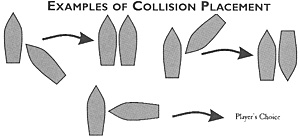 EXAMPLES OF COLLISION PLACEMENT
EXAMPLES OF COLLISION PLACEMENT
When two ships collide during a turn, it negates the affects of any movement orders given for the rest of that turn (all remaining phases).
COLLISION DAMAGE
If a ship traveling at a speed of 1 inch per turn collides with another vessel, neither ship takes any damage.
If a ship is traveling at a speed greater than 1 inch per turn collides with another vessel, both ships take I point of hull damage.
CUTTING AND RUNNING
A ship that is alongside another ship may attempt to cut and run as long as it retains the ability to raise sail. During the next Movement Orders sequence, the player must raise sail and move forward to escape. Of course, if the other player does the same (if they are able to do the same), it will result in another collision and will have to start over again.
PRIZE CREWS
If a ship strikes its colors, the ship that captured it may use its own crew and/or marine detachments as a prize crew to take control of the vessel and use it themselves. One marine detachment is required to simply operate the captured vessel (execute movement actions). Reduce the capturing ship's marine detachments by one for this purpose. To further man the captured ship, the capturing vessel must use its own gun battery crews or additional marine detachments to man undestroyed cannon batteries. Remove marine detachments or mark off gun batteries on the capturing vessel per battery to be manned on the captured vessel. NOTE: only the crew transfer, NOT their weapons. There is no restriction on gun battery types. Thus a cannonade battery could be removed from the capturing ship to man long range guns on the prize vessel.
Use the captured ship's control diagram, and mark off the required marine detachments or gun batteries from the vessel who gave up the prize crew. The captured vessel regains one morale box (the last one), and takes on the morale factor of the capturing vessel. NOTE: A prize crew does NOT count as a marine detachment on the captured vessel. A ship must allocate additional marine detachments specifically for that purpose if it wishes to have marine detachments on the captured vessel.
EXAMPLE:
The HMS Victory captures the French vessel Monarca, which strikes her colors. The Monarca is still able to make sail at the speed of 1 inch per turn, so the Captain of the Victory decides to send a prize crew. At the time of the capture, the Victory has 4 remaining marine detachments. Since the battle is not yet over, the Captain of the Victory decides to commit two of his detachments to the Monarca as a prize crew, husbanding two detachment to defend the Victory. In addition, he decides to release two of his Short range gun crews to man long range batteries on the Monarca. One marine detachment mans the ship. The short range gun crews man long range cannon batteries that are still capable of firing. The last marine detachment is used as a damage control party to attempt repairs on the Monarca.
SEQUENCE 8- DAMAGE CONTROL
At the end of each turn, a vessel may attempt to make a single repair from the following list:
- Repair 1 hull point
Repair 1 mast point
Repair the ship's wheel
Repair the ship's rudder
Put out a fire
Restore a destroyed cannon battery
Roll a single six sided die to make a repair attempt. A repair is successful if the roll results in a 5 or 6. A ship may increase the odds of success by marking off a marine detachment for bonuses to the die roll at the rate of one detachment per +1 added to the roll. The maximum bonus that can be gained in this manner is +2. The marine detachments are lost for the next full turn if used in this manner, regardless of success or failure. The marine detachments used for repair become available again during the next damage control sequence.
Example: The HMS Minotaur is on fire and has two points of damage to her mast. Her Captain decides to put the fire out immediately and uses all available hands to do so. The Captain assigns two marine detachments (the maximum allowable) to assist. He then rolls a 3, which becomes a 5, putting out the fire. The marine detachments will not be available for use again until the next Damage Control phase, at which time they may again be used in damage control, or returned to service as marine detachments.
SINKING
As mentioned above, a ship sinks only if it is reduced to zero hull points. At this point, it is too late to conduct any repairs.
VICTORY CONDITIONS
Each scenario will have its own set of victory conditions based on the following criteria.
DUEL This is a straight on fight between two ships or two small groups of ships. The side that holds the local sea at the end of the battle will emerge victorious. Victory conditions for a duel are as follows:
- Major Victory- Force opponent to sink, or capture them as a prize.
Minor Victory- Force opponent to flee the playing area.
Draw- Both sides flee or are sunk.
ESCAPE
In an escape scenario, one force wins if they exit the map on a certain side of the playing surface. Points are scored by the escaping force per the number of guns of each escaping vessel. Points are scored for the blocking force for each ship they cause to strike colors or sink. The side with the most points scored at the end of the scenario wins.
In multi-ship engagements, victory points are scored by the number of guns of defeated ships. Scenarios with unique victory conditions will have them listed.
ADVANCED RULES
NAVIGATIONAL HAZARDS
In the basic game, there are no navigational issues to worry about- no reefs, or shorelines, or sand bars. There's just open ocean and lots of it.
However, many historical battles were fought near to shore, or in situations where a shoal was undiscovered until a ship happened upon it at the worst possible moment. The advanced rules presented here allow players to add these hazards to their games.
SINKING SHIPS
A sinking ship didn't just immediately go down to Davy Jones' locker. Usually it would sink slowly beneath the waves.
When a ship sinks, roll a single six sided dice. This indicates the number of phases (counting from the next phase) until the ship is considered sunk. A roll of one indicates a ship sinks immediately, and is considered no longer a hazard in the next phase, while a 4 indicates that a ship will no longer be considered a hazard in the 4th phase after the current one, etc.
If a ship collides with a sinking ship before it has sunk, it follows the standard collision rules.
LAND
Any bit of land sticking out of the surface, be it a reef, sandbar, bit of rock, or solid land, is considered land for purposes of this rule. If it sticks out of the water, it's land. If a ship collides with land, it is treated as a collision. Unlike the normal collision rules, however, the ship colliding with land takes 1 point of damage per rate of speed at the time it hit land.
EXAMPLE
The HMS Argos is traveling at speed three when it crashes into the docks at Brest. It takes 3 hull points of damage.
BEACHING
Beaching is when a ship strikes a solid object and cannot move. If a ship hits land, it is considered automatically beached. A beached ship becomes simply a stationary gun battery with a limited firing arc (rules for towing will be presented in a future supplement and will present options for pulling a ship off of the beach). For all other purposes, it is out of the game.
SHALLOW SEAS
If a ship travels into shallow water, it is taking a considerable risk of hitting bottom and doing damage to her hull and/or beaching. Shallow water is marked with a level that indicates how shallow the water is. Higher numbers indicate shallower water than lower numbers. If a ship enters shallow water, make a roll for each movement phase it moves through the shallow water. Subtract the ship rating from the die roll. If the resulting number is higher than the level of the shallows, the ship hits bottom.
Unrated combat ships are considered 6th rates for purposes of this roll. A future supplement will contain rules for merchant ships, which have their own load rules.
A ship striking bottom immediately takes one point of hull damage for each inch of speed it is currently traveling. The ship comes to an immediate stop and is in danger of beaching. To avoid beaching, a ship that strikes bottom must make a second roll against shallow water. If this roll succeeds, the ship may get underway again. If the second roll fails, the ship is beached (see above).
UNDERWATER SHOALS/ REEFS
Underwater shoals and underwater reefs are hidden hazards underneath the waves. In some scenarios, a defending player may designate shoals that are known to their own forces but not to the enemy. The position and size of the shoal should be precisely written down and revealed if the enemy stumbles upon it. In other scenarios, shoals simply act as known hazards for both sides. The shoals should be marked on the map for both parties to see.
Shoals function in the same fashion as shallow water and follow the same rules (see above).
Hold Fast Rules for the Age of Sail
- Hold Fast Rules
Scenario I: French Honor and Glory
Scenario II: Battle of L'Insurgente
Scenario III: Vengeance is Mine
Scenario IV: Flight From Venice
Scenario V: Hot Java
Scenario VI: An Irish Fist Fight
Sample Ship Ratings and Blank Diagrams
Back to MWAN # 129 Table of Contents
Back to MWAN List of Issues
Back to MagWeb Magazine List
© Copyright 2004 Hal Thinglum
This article appears in MagWeb.com (Magazine Web) on the Internet World Wide Web.
Other articles from military history and related magazines are available at http://www.magweb.com